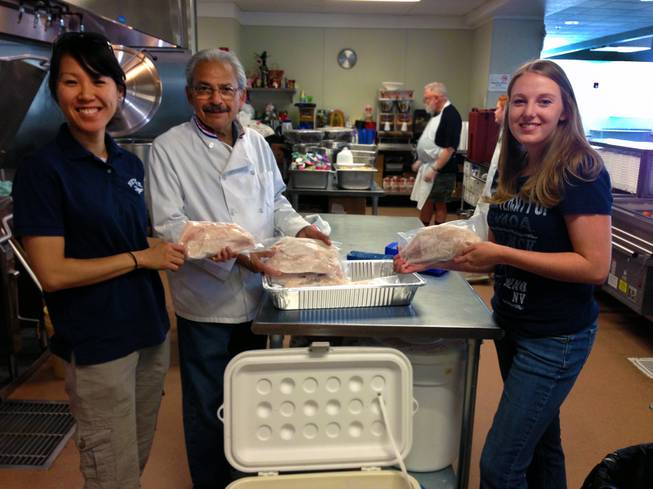
Mike Wolterbeek, UNR / AP
From left, Christine Ngai, leader of a research project for UNR’s Aquatic Ecosystems Analysis Laboratory; Ray Trevino, chef of the St. Vincent’s dining hall and food pantry; and Emily Ulrich, a research technician at the UNR lab, hold some of the fish that were removed from Lake Tahoe in an effort to combat invasive species and now are being used in meals for the homeless at the pantry’s kitchen in downtown Reno.
Monday, Aug. 17, 2015 | 2 a.m.
Largemouth bass and bluegills that were making their home in parts of Lake Tahoe where they don't belong are ending up in the stomachs of some of Nevada's poor and homeless as part of an offshoot of a research project to combat invasive species.
Scientists at the University of Nevada, Reno have entered into a partnership with area conservation groups and a food pantry affiliated with a local homeless shelter to make sure the aquatic trespassers they remove from the alpine waters don't go to waste.
About 55 pounds of fish filets, mostly bass and bluegills, have been sent since May to the St. Vincent Dining Room operated in downtown Reno by Catholic Charities of Northern Nevada.
Smaller-bodied fish, not suitable for filleting, are processed and distributed to the Animal Ark Wildlife Shelter in Reno. Remaining fish by-product is transported for composting with local processor Full Circle Soils & Compost in Gardnerville.
Christine Ngai, project lead and researcher at UNR's Aquatic Ecosystems Analysis Laboratory, said they use a common fisheries survey method known as "electrofishing" to separate the native from the non-native fish. After temporarily stunning the fish, scientists scoop out the invaders with nets while the native fish return to normal in a few minutes and swim away, she said.
Catholic Charities spokeswoman Auburn Harrison said Ngai contacted them about a year ago and asked if they could accept donations of vacuum-packed fish.
"We told her absolutely," Harrison said. "Every little bit of food helps, and it's nice to know the fish are going into the bellies of people who are hungry."
On average, more than 500 men and women eat a daily meal at St. Vincent's where Chef Ray Trevino sometimes uses the fish in casseroles but usually pan fries it with butter and other spices, she said.
"Fresh fish caught in Tahoe and prepared just a few days later is really, really good. Delicious, actually," Harrison said.
The research, conducted in collaboration with the California Department of Fish and Wildlife, has zeroed in on the Tahoe Keys on the lake's south shore as the primary spawning area for nonnative, warm-water fish that apparently were introduced into the waters decades ago.
The university launched a 3-year pilot project in 2011 targeting fish in the Tahoe Keys. Recently, operations were expanded to the east shore near Cave Rock and on the north end in Crystal Bay near the California-Nevada line thanks to grants from the California Tahoe Resources Conservation District and Tahoe Regional Planning Agency, UNR spokesman Mike Wolterbeek said.
"During the pilot project, we removed the 50,000 fish mainly from the Tahoe Keys at south shore," Ngai said. "This year, we are glad to keep things rolling again and are monitoring other areas around the lake."
Researchers say the invaders damage the habitat for native fish and have virtually eliminated the native minnow population at the Tahoe Keys.
"In Lake Tahoe, since 1960, there has been a tenfold decline in native fishes, but what we also know is that these recent invaders could further depress the native population through competition and predation," said Sudeep Chandra, a freshwater scientist and director of the UNR lab.
"We are also trying to determine the extent to which these fish are moving into the main part of the lake and when and where they might be moving," Chandra said. "We've found, and studies by scientists at other lakes have confirmed, that we must target the large spawning adult fish, and need continuous efforts, on a yearly basis, to be effective."

Join the Discussion:
Check this out for a full explanation of our conversion to the LiveFyre commenting system and instructions on how to sign up for an account.
Full comments policy